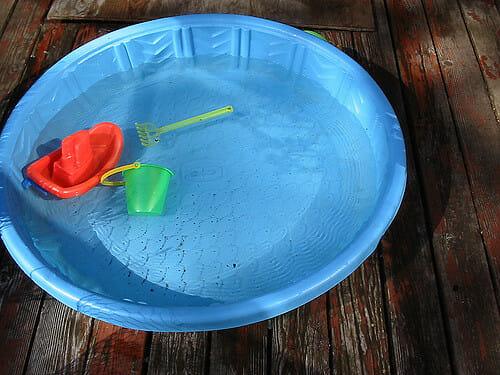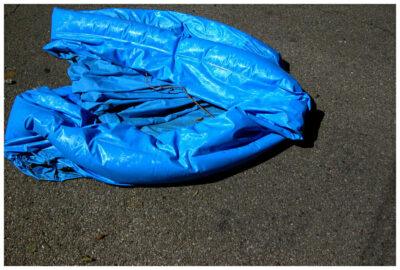You probably thought they had no purpose other than giving your kids hours and hours of fun in the yard each summer. But kiddie pools can serve many uses during an emergency situation.
Splasher or wading pools, as they’re called, come very cheap these days. The rigid ones are more durable and easier to use and clean. They are lightweight, self-supporting and portable. They tend to take up more space in storage, though.
The inflatable ones, of course, need to be blown up or pumped. They’re made out of soft vinyl and can be folded up to a small size and returned to their boxes after use. The bigger, more expensive ones usually come with a pump and a repair patch, as vinyl is prone to rips and punctures.
Thinking of what else to add to your emergency preps? Check out the suggestions below. You may never think of kiddie pools the same way again. You might even decide to get a few more while stocks are plentiful and before they’re taken away from store shelves.
1. Emergency water storage. In any disaster, securing water should a top priority. Clean, potable water is essential not just for drinking but also for food preparation and hygiene. Once you’ve filled all possible containers in your home – the bathtub, empty gallons, buckets and drums – the kiddie pool should be the next thing to run to. Small ones can hold 30-50 gallons, while larger ones that can fit a family of 4 or 5 can hold up to 5000 gallons. Calculate your family’s water needs. DHS recommends that each person should be self-sufficient for at least 72 hours in case of a disaster, and each adult consumes about a gallon a day on average. (More for nursing women, active children and the sick. And more so during hot weather.) How many will your family need over a stretch of, say, a week or two — over and above cooking and bathing? And don’t forget about the pets, too.
Discover The Secrets Of The Word’s Top Survivalists!
Remember to purify the water before drinking, and to keep the pool covered to protect it from bugs and debris. A dark tarp should shield it from sunshine, which encourages growth of algae; while some plastic sheeting fitted around the edges would minimize loss due to evaporation.
2. Rainwater collection. If water in your area is scarce and local laws allow you to collect rain, kiddie pools would be your next best resource after you’ve filled up your barrels and drums. You can use the water for bathing your pets, washing your car, flushing the toilet and watering the garden. Don’t source rainwater from roof gutters if you intend to use it for drinking, as it might be contaminated with bird droppings.
3. Birthing pool. Pregnant mothers expecting a normal delivery may opt to do a home birth, and a big, sturdy inflatable could provide just the amenity. There are ones that are strong, wide and comfortable enough to support a water birth. Make sure it’s also deep enough for mommy to sink down into, with water reaching up over her abdomen. A height of about two feet would be ideal so she can lean her back comfortably against its wall.
4. Emergency raft. Transportation is invaluable during a massive flood, and an inflatable pool can serve that purpose. Be sure its size and strength can hold the passenger’s weight, though. As for the hard plastic kind, a 2hp outboard boat motor can actually be attached to it to make an improvised boat – strong enough to carry a normal-weight teenager.
https://www.youtube.com/watch?v=ZFgpKXHsg-g
5. Laundry/bathtub. Rig a shower from a cistern and use a kiddie pool as a tub. You can then save the grey water for flushing the toilet. Additionally, the pool could serve as a giant basin for hand washing your laundry.
6. Fish pond, duck bath. Live near a river or lake where you can fish? Bring your fresh catch home and dump them in your pool. They’ll stay fresh longer and maybe even thrive for a good number of days. You might even decide to breed them there to increase your supply of meat.
Kiddie pools would also make ideal duck pens. These “raised ponds” can be drained later and the water used for the garden.
7. Mixing and sorting. Mix grains, pasta, beans or any bulk amounts of dry food you’ve stockpiled that you want pre-mixed before re-packing and storing. Think of your pool as a giant mixing bowl. In the garden, these pools are also great receptacles in which to mix soil if you need to amend it with compost. When compost itself is riddled with twigs, stones, nut shells or anything that’s just taking too long to break down, sort it there.
8. Garden bed. Using the rigid kind of pool, just add soil and you’re ready to plant herbs, veggies and flowers. Raised beds are always ideal in areas where there’s poor or no soil, like a patio in an apartment or condominium. You can easily prop these on a table for easy, gentle watering.
Have you seen any leaky ones being thrown out or given away at a yard sale? Grab them! Holes and punctures are no problem, since they’ll make great drainage for your raised beds.
9. Playpen. Keeping your baby or toddler in an inflatable one that’s strong and high enough will allow you to work in the garden and do other outdoor tasks. You can watch and talk to him as you do, making sure he has enough toys to keep him busy and happy.
What uses would you add to our list? Share your tips in the section below:
 Off The Grid News Better Ideas For Off The Grid Living
Off The Grid News Better Ideas For Off The Grid Living





